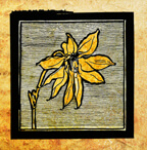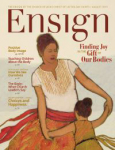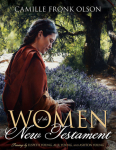“Here Bring Your Wounded Hearts”
{ Phoebe }
Painted by Elspeth Young
« Previous Painting • Next Painting »
I commend unto you Phebe [Phoebe] our sister, which is a servant of the church which is at Cenchrea: That ye receive her in the Lord, as becometh saints, and that ye assist her in whatsoever business she hath need of you: for she hath been a succourer of many, and of myself also.
The story behind Here Bring Your Wounded Hearts
Phoebe is depicted in the angelic role of "succourer of many"--one who emulates the Savior, who is described as One knowing "how to succor his people according to their infirmities" (Alma 7:12) and who "is able to succour them that are tempted" (Hebrews 12:18; see also D&C 62:1). When Paul describes the Messiah as one who "is able to succour," he uses the Greek word "boetheo," meaning "to run to the cry of those in danger" to "help, succor, bring aid" (Blue Letter Bible at www.blueletterbible.org).
As a disciple of Christ, Phoebe does likewise. Her compassionate arm encircles the widow at the focal point of the painting, and reminds us of the Lord's stirring injunction to "succor the weak, lift up the hands which hang down, and strengthen the feeble knees" (D&C 81:5).
Paul also describes Phoebe as being liberal in providing temporal assistance by sharing her own substance. Paul does so by using the Greek word "prostatis," which denotes Phoebe's care as a "guardian, protectress, patroness, caring for the affairs of others and aiding them with her resources" (Blue Letter Bible at www.blueletterbible.org). He uses the word "diakonsos," meaning one commissioned to minister to and care for the poor and the needy, distributing "the money collected for their use" (Blue Letter Bible at www.blueletterbible.org).
In other words, Phoebe lived the reality of King Benjamin's teaching that a vital means of retaining a remission of one's sins includes "succor[ing] those that stand in need of succor" by "administer[ing] of your substance unto him that standeth in need...not suffer[ing] that the beggar putteth up his petition to you in vain" (see Mosiah 4:12-16).
Phoebe's example teaches anew the truth taught by the Savior that "whosoever will be great among you, shall be your minister" and "if any man serve me, let him follow me, and where I am, there shall also my servant be" (see Mark 10:43 and John 12:26).
The title of the painting comes from the lyrics of Come, Ye Disconsolate (written by Thomas Moore (1779-1852) and published in Sacred Songs, 1816):
Come, ye disconsolate, where'er ye languish,
Come, at the shrine of God fervently kneel;
Here bring your wounded hearts; here tell your anguish;
Earth has no sorrow that heaven cannot heal.
Symbolism in Here Bring Your Wounded Hearts
"For some reason, we think the Atonement of Christ applies only at the end of mortal life to redemption from the Fall, from spiritual death. It is much more than that. It is an ever-present power to call upon in everyday life. When we are racked or harrowed up or tormented by guilt or burdened with grief, He can heal us. While we do not fully understand how the Atonement of Christ was made, we can experience 'the peace of God, which passeth all understanding'" ("The Touch of the Master's Hand," Liahona, July 2001, p. 26; Ensign, May 2001, p. 23).
The young widow cradles beautiful white cyclamen blossoms in her hand--a second focal point to attract the viewer's gaze. These flowers represent the comfort, available to all who mourn; comnfort to be found in the joyful angelic pronouncement: "He is not here, but is risen" (see Luke 24:6 and Matthew 28:6). It is the hope echoed by Joseph B. Wirhlin's timeless promise: "I testify to you in the name of the One who conquered death--Sunday will come. In the darkness of our sorrow, Sunday will come. No matter our desperation, no matter our grief, in this life or the next, Sunday will come" (Joseph B. Wirthlin, "Sunday Will Come," New Era, March 2008, pp. 2-5).
The fresco behind the figures recalls Italian artistic traditions, and simply reminds the viewer of the setting for Phoebe's ministrations.
The two women have hairstyles akin to those in Rome during the period represented in the painting. Extant marble busts of notable women from the Empire Period in Rome show styles consisting of intricate braids and piles of curls, which are echoed in the subdued hairstyles chosen by the artist--a "daily life" version mimicking the more elaborate trends of the day. The widow wears a black head wrap and tunic, symbolic of her mourning, while the elaborate gold and blue wrap draped about Phoebe's shoulders symbolizes her thoughtful care ("the bond of charity," which, like a "mantle, which is the bond of perfectness and peace" enfolds both giver and receiver in the pure love of Christ (see D&C 88:125).
The painting, as a whole, also attempts to remind us that when confronted with the helplessness we feel upon hearing of the suffering of others, Phoebe's example as one who did "what she could" (see Mark 14:8) suffices to compensate for our own weakness whenever we attempt to succor those in need. Her timeless example reminds us that "in the end, the number of prayers we say may contribute to our happiness, but the number of prayers we answer may be of even greater importance. Let us open our eyes and see the heavy hearts, notice the loneliness and despair; let us feel the silent prayers of others around us, and let us be an instrument in the hands of the Lord to answer those prayers" (Dieter F. Uchtdorf, "Happiness, Your Heritage," October 2008 General Conference of The Church of Jesus Christ of Latter-day Saints).
Curatorial Details
Copyright and terms of use
© By Elspeth Young, All Rights Reserved. You may not print, copy, or reproduce this artwork or make derivative works from it without the prior written consent of the copyright holder. For permissions, please review our FAQ page.From the Newsroom

By Al R. Young
only high-end custom frames
We have framed our own artworks for more than 30 years, and during that time we have provided a variety of framing services to patrons upon request. For many reasons—including constant changes in the availability of moulding styles—we cannot offer off-the-shelf framing options or response times typically associated with such a service. Of necessity, all of our framing projects are aproached, priced, and billed as constuling projects... Read more »
Tags: Into The West, Spring Rain, North Country, The Grey Havens, Journey's End, Looking Back, Enchanted Stillness, Bedtime Story, In The High Valley, The Daydream, Before The Ball, Old Shannon, Pavane, Sweet Brier, Legend, Mountain Home, And I...

By Elspeth C. Young
the story in this painting
the creation of this paintingOriginal artworks produced by the Artists of Al Young Studios are part of themed collections because the Studios is organized after the pattern of the Renaissance workshops of the old masters. The Artists take the long view of their work as being a lifetime journey toward mastery of artistic expression through selected techniques, reaching as far back as the 16th century. Artists work as peers in an intensely creative community in which each artist pursues his or her own work as part of the group's philosophy... Read more »

By Al R. Young This brief article presented New Testament commentary and study aids.Here Bring Your Wounded Hearts... Read more »
Tags: Here Bring Your Wounded Hearts, 3rd-party Publications, 2019, News

By Al R. Young Women of the New Testament by Camille Fronk Olson is the companion volume to Women of the Old Testament, published by Deseret Book in 2009.
The New Testament volume features fifty six illustrations from the Artists of Al Young Studios, listed here under the Studios' fine art collections and portfolios to which they belong.
From the Women of the Bible Fine Art CollectionFull-color details (cropped images) from the following 29 paintings appeared in the book (in the order in which they appear here)... Read more »
Tags: I Shall Be Whole, I Say Unto Thee, Arise, The Windows Of Heaven, The Miracle Of Forgiveness, What Is Truth, Under Whose Wings Thou Art Come To Trust, Unto The City Of David, A Damsel Came To Hearken, By The Wayside, Living Water, Waiting...

By Al R. Young This blank-book journal sells for $32 (plus shipping) direct from Al Young Studios. Printed in full color on heavy paper, the book is bound with black plastic spiral to rest flat when open.
At Home: A Personal Journal features 128 original artworks consisting of 51 original oil paintings from the Artists of Al Young Studios, 44 images from the Studios' Limited Editions Collection, nine pen and ink drawings and block prints by Ashton, seven of Al's exquisitely crafted pencil drawings, and one lithograph from his private portfolios... Read more »
Tags: North Shore, Nasturtium, Wald Kirche, Scabiosa, Foxglove, Narcissus on beige paper, July, Columbine, Maine, Final Draft, Unfurling, Back Shore, Summer's End, Gifts of Morn, Black-eyed Susan, Land's End, Solitude, The Limberlost, Perdita,

By Al R. Young This blank-book journal sells for $32 (plus shipping) direct from Al Young Studios. Printed in full color on heavy paper, the book is bound with black plastic spiral to rest flat when open.
Inspirations features 163 artworks along with 53 commentaries—written by the Artists of Al Young Studios especially for this journal—on such topics as their creative process, the creative environment of the Studios, technical approaches to their artwork, and inspiration from the works of other artists... Read more »
Tags: Untitled, In the Clearing, Anne Girl, Spring Rain, Journey's End, Enchanted Stillness, Bedtime Story, In The High Valley, Mountain Home, And I Will Not Deny The Christ, Sara Crewe, And My Soul Hungered, 3.00.0246.010, The Road To Melek, We...

By Al R. Young
High-resolution digital copies are available from the Studios for use as illustrations. Use the serial number—appearing below the thumbnail—in requesting permission from the Studios (see links at the bottom of this page for detail).
The correct form of attribution when publishing an image is specified in the license agreement issued to the publisher by Al Young Studios.Guidelines for requests to copy or publish artworks created by the Artists of Al Young Studios
Guidelines for commissioning Al Young Studios to create illustrations
Return to this portfolio
Browse all portfolios
Browse Newsroom articles about Illustration
The original image is available for sale, please contact us for details... Read more »
Tags: Here Bring Your Wounded Hearts, 2011, People and Stories of the Bible

By Al R. Young Here Bring Your Wounded Hearts is the newest oil painting to be added to the line of original artworks from Al Young Studios.
Click here to see a larger image of the new painting, read the artist's commentary, and look at the selection of prints--if any are available.... Read more »
Tags: Here Bring Your Wounded Hearts, 2011, Elspeth C. Young, Legacy, News, Oil paintings and prints, Women of the Bible Art Collection

By Elspeth C. Young
Strange as it may sound (we often surprise Studio visitors with this one!), working on a painting while the panel is turned upside-down, as shown above, can be a marvelous problem-solver during an otherwise difficult painting session. In the final stages of her painting of Phebe, for instance, Elspeth has spent several painting sessions over the last couple of weeks, with the panel inverted. This technique enables the artist to "forget" that he or she is painting a face, an eye, a hand, etc... Read more »
Tags: Here Bring Your Wounded Hearts, 2011, Tips and techniques, Women of the Bible Art Collection